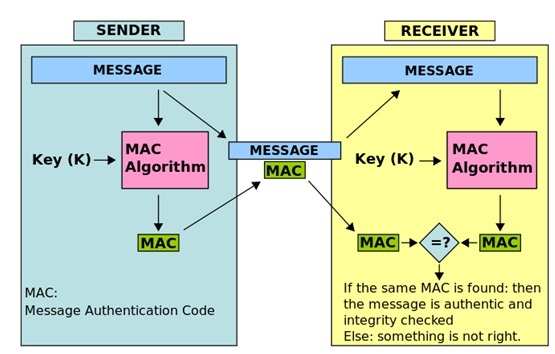There is no such thing as a Signature-Based MAC. Being the wrong choice in the list, it is the best answer to this question.
WHAT IS A Message Authentication Code (MAC)? In Cryptography, a MAC (Message Authentication Code) also known as a cryptographic checksum, is a small block of data that is generated using a secret key and then appended to the message. When the message is received, the recipient can generate their own MAC using the secret key, and thereby know that the message has not changed either accidentally or intentionally in transit. Of course, this assurance is only as strong as the trust that the two parties have that no one else has access to the secret key. A MAC is a small representation of a message and has the following characteristics:
A MAC is much smaller than the message generating it. Given a MAC, it is impractical to compute the message that generated it. Given a MAC and the message that generated it, it is impractical to find another message generating the same MAC.
See the graphic below from Wikipedia showing the creation of a MAC value:

Message Authentication Code MAC HMAC In the example above, the sender of a message runs it through a MAC algorithm to produce a MAC data tag. The message and the MAC tag are then sent to the receiver. The receiver in turn runs the message portion of the transmission through the same MAC algorithm using the same key, producing a second MAC data tag. The receiver then compares the first MAC tag received in the transmission to the second generated MAC tag. If they are identical, the receiver can safely assume that the integrity of the message was not compromised, and the message was not altered or tampered with during transmission.
However, to allow the receiver to be able to detect replay attacks, the message itself must contain data that assures that this same message can only be sent once (e.g. time stamp, sequence number or use of a one-time MAC). Otherwise an attacker could — without even understanding its content — record this message and play it back at a later time, producing the same result as the original sender. NOTE: There are many ways of producing a MAC value. Below you have a short list of some implementation.
The following were incorrect answers for this question:
They were all incorrect answers because they are all real type of MAC implementation. In the case of DES-CBC, a MAC is generated using the DES algorithm in CBC mode, and the secret DES key is shared by the sender and the receiver. The MAC is actually just the last block of ciphertext generated by the algorithm. This block of data (64 bits) is attached to the unencrypted message and transmitted to the far end. All previous blocks of encrypted data are discarded to prevent any attack on the MAC itself. The receiver can just generate his own MAC using the secret DES key he shares to ensure message integrity and authentication. He knows that the message has not changed because the chaining function of CBC would significantly alter the last block of data if any bit had changed anywhere in the message. He knows the source of the message (authentication) because only one other person holds the secret key.
A Keyed-hash message authentication code (HMAC) is a specific construction for calculating a message authentication code (MAC) involving a cryptographic hash function in combination with a secret cryptographic key. As with any MAC, it may be used to simultaneously verify both the data integrity and the authentication of a message. Any cryptographic hash function, such as MD5, SHA-1, may be used in the calculation of an HMAC; the resulting MAC algorithm is termed HMAC-MD5 or HMAC-SHA1 accordingly. The cryptographic strength of the HMAC depends upon the cryptographic strength of the underlying hash function, the size of its hash output, and on the size and quality of the key.
A message authentication code based on universal hashing, or UMAC, is a type of message authentication code (MAC) calculated choosing a hash function from a class of hash functions according to some secret (random) process and applying it to the message. The resulting digest or fingerprint is then encrypted to hide the identity of the hash function used. As with any MAC, it may be used to simultaneously verify both the data integrity and the authenticity of a message. UMAC is specified in RFC 4418, it has provable cryptographic strength and is usually a lot less computationally intensive than other MACs.
What is the MicMac (confusion) with MIC and MAC? The term message integrity code (MIC) is frequently substituted for the term MAC, especially in communications, where the acronym MAC traditionally stands for Media Access Control when referring to Networking. However, some authors use MIC as a distinctly different term from a MAC; in their usage of the term the MIC operation does not use secret keys. This lack of security means that any MIC intended for use gauging message integrity should be encrypted or otherwise be protected against tampering. MIC algorithms are created such that a given message will always produce the same MIC assuming the same algorithm is used to generate both. Conversely, MAC algorithms are designed to produce matching MACs only if the same message, secret key and initialization vector are input to the same algorithm. MICs do not use secret keys and, when taken on their own, are therefore a much less reliable gauge of message integrity than MACs. Because MACs use secret keys, they do not necessarily need to be encrypted to provide the same level of assurance.
Reference(s) used for this question: Hernandez CISSP, Steven (2012-12-21). Official (ISC)2 Guide to the CISSP CBK, Third Edition ((ISC)2 Press) (Kindle Locations 15799-15815). Auerbach Publications. Kindle Edition. and
http://en.wikipedia.org/wiki/Message_authentication_code and
http://tools.ietf.org/html/rfc4418